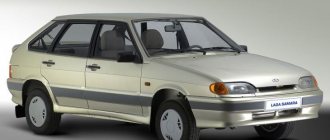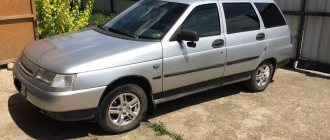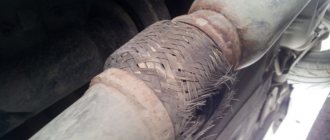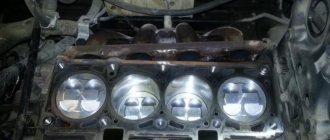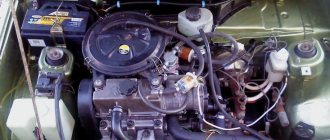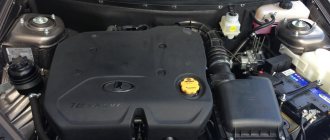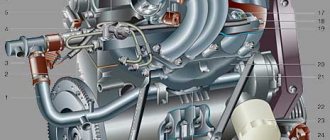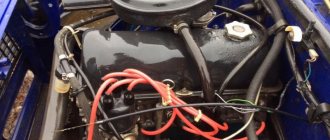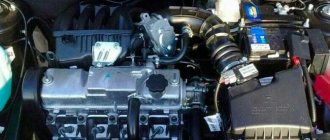Most VAZ models do not have high speed and power characteristics. They are excellent for daily driving: low consumption, good reliability of units, high maintainability. However, due to the enormous popularity of the cars, many drivers are wondering what kind of acceleration to 100 VAZ 2114 is. in different years of production, several types of engines were installed on the car, each of them producing different performance indicators. Let's look at overclocking each of the 4's variations.
Useful video:
Differences between VAZ 2114 and VAZ 2109
The improvements of the VAZ 2114 in comparison with the prototype turned out to be more than serious. They affected both the appearance and the technical part of the car.
2114 designers made a number of changes:
- new front and rear bumpers installed;
- updated version of the hood;
- the model received improved optics;
- the radiator was lined;
- added a package of moldings.
The interior of the car has changed even more. The instrument panel and steering wheel were completely replaced. To improve passenger and driver comfort, engineers replaced the outdated heater. The 2114 also received new front windshield wipers.
Price for VAZ 2114
Of course, most owners of domestically produced cars choose VAZ cars precisely because of their low cost. The price for the 16 valve VAZ 2114 is in an equally acceptable range, but at the same time you can count not only on efficiency, but also on fairly good performance of this vehicle.
Prices today for a 16-valve model fluctuate around 300 thousand rubles.
Engine VAZ 2114
The most anticipated changes to the VAZ 2109 concerned the power plant. In the first generation, the model used an 8-valve engine 2114. It had a displacement of 1.5 liters. In the next update of the VAZ 2114, which occurred in 2007, this engine was replaced with an improved one with a volume of 1.6 liters.
The installation of a 16-valve engine on the VAZ 2114 was a real breakthrough for the model. This modernization was carried out entirely under the control of Super-Avto CJSC, part of AvtoVAZ OJSC. The most important characteristic of the 16 valve VAZ 2114 is the maximum power of 89 hp. Thus, the car is technically very close to foreign-made budget cars.
For comparison, we suggest you consider the following table of dynamic indicators:
| LADA 2114 8V | LADA 2114 16V | |
| Maximum power, kW/rpm/hp | 59,5/5200/81 | 66/5000/89 |
| Maximum torque, Nm at rpm | 120/2700 | 131/3700 |
| Fuel consumption in mixed mode, l/100km | 7,6 | 7,0 |
| Maximum speed, km/h | 160 | 190 |
| Acceleration to 100 km/h, s | 13,2 | 11,2 |
Acceleration to 100 km/h with a volume of 1.6
A few years later, after the standard 1.5-liter engine was modified, the “four” began to be equipped with more modern 1.6-liter units. Due to the modified cylinder block, an increase of 5 horsepower was achieved.
Taking into account the light weight of the car body and a slightly modified engine, acceleration to hundreds began to take exactly 13 seconds .
As the drivers themselves note, competent work with the gearbox during acceleration allows you to achieve even better results. There are often cases when a “departure” of 12 seconds is recorded.
Acceleration to 100 km/h of the VAZ 2114 according to the passport for the version with an 82-horsepower engine is exactly 13 seconds. This is still enough for daily driving in city traffic, but improvements are being made for more dynamic movement. By warming up the rubber, removing the catalyst, and flashing the engine’s “brains,” it can be removed in up to 1-2 seconds. It is clear that this reduces the service life of the engine, but considering the cost of repairs, this is not so critical.
Road characteristics of the VAZ 2114
In addition to the fact that a 16-valve engine was installed on the model, the VAZ 2114 was significantly re-equipped to improve road properties. The car's gearbox with a gear ratio of 3.7 received a new package of “closed” bearings, which significantly increased the reliability and performance of the system, in particular the torque of the car.
For the braking system of the 16-valve VAZ 2114, engineers used larger diameter (up to 200) clutch brake discs than in 2109. In addition, the brake cooling system was improved, which made it possible to achieve not only safety, but also reliability.
The designers managed to achieve great success in terms of vehicle stability. This was mainly possible thanks to the installation of high-energy shock absorbers, as well as struts from the 2107 model. This set of procedures led to increased body rigidity, road stability, maneuverability and durability.
Acceleration to 100 km/h with a volume of 1.5
Because the first samples with a carburetor fuel supply system were installed on the 2115 model; the “fours” were always distinguished by higher “agility” due to the presence of an injector. The first injection engines on the “four” produced 79 horsepower (some sources indicate only 77 horsepower).
It is clear that by today's standards this is a rather modest result for a 1.5-liter engine. At the same time, such “power” and the presence of an injector made the fourteenth model a rather dynamic car.
With a working manual gearbox, a car with the first samples of the 79-horsepower VAZ engine could be accelerated to 100 km/h in 13.2 seconds .
If desired, the acceleration of the VAZ 2114 can be accelerated in simple ways: remove the air filter housing, install alloy wheels, choose the right tires, or lighten the car. At the end of the day, these manipulations will allow you to remove a couple of tenths of seconds. More serious improvements require a lot of money.
Reviews of VAZ 2114
Reviews about the 16 valve VAZ 2114 can be said to be mostly positive. In comparison with the 8-valve version, drivers highlight:
- Reduced fuel consumption;
- Increased power;
- Improved overall dynamics.
On the other hand, let's not hide it and look at the weaknesses of the car. As you know, the 16 valve model never entered mass production, and this led to several negative factors at once.
- Firstly, it is not always possible to obtain good quality assembly, which is carried out at Super-Avto CJSC.
- Secondly, the car is expensive to repair, as some spare parts are difficult to obtain.
Acceleration to 100 km/h Super-Auto
The most recent cars of the fourteenth model based on the Super-Auto division began to be equipped with 16-valve engines. From that moment on, acceleration to one hundred kilometers per hour on the “four” became much faster. Proven variations of the 16-valve engine began to be installed on the car - 124 and 126 units. Each of them produces 98 horsepower.
In combination with a practically stock gearbox, the car can reach 100 km/h in 11.2 seconds .
Even with small investments, some owners manage to drive out in less than 10 seconds, which is not bad for a domestic car.
The increased engine capacity in the Super-auto variation did not affect fuel consumption. On the contrary, due to a more modern fuel injection system, it was possible to achieve a reduction in fuel consumption (6.9-7 liters per hundred km). On 16-valve engines there is a plus in the form of low operating volume, as well as high torque (132 N/m)
Useful : The most complete technical specifications of the VAZ 2114
Choosing from the listed options, we note 2114 in the “Super-Auto” variation. A modern engine, low consumption and high dynamics, the presence of body struts - all this is combined in the hatchback version from Super-Auto.
What engines drive the VAZ-2114
"VAZ-2114" was produced from 2001 to 2013. Until 2007, it was equipped with a 1.5 77 hp engine. With. It easily lasted 200 thousand km, but was disappointing with noise, knocking and thermostat failure. In the 2007 models, a 1.6 engine with 81 hp appeared. With. It has more torque, but makes noise like a diesel engine.
Both versions work with a five-speed manual transmission. Sometimes there are cars with a 16-valve 1.6 engine with a capacity of 90 or 98 hp. With. It is one of the best from AvtoVAZ, especially for those who like to tune and modify the engine.
TECHNICAL CHARACTERISTICS OF THE FOURTEENTH
First, let's look at the main characteristics of the VAZ 2114.
The fourteenth model is a 5-door hatchback, with the following body dimensions (mm): L – 4112, W – 1650, H – 1402. Vehicle weight – 970 kilograms, maximum loading weight – 470 kg.
The wheelbase of the VAZ 2114 is similar to the nine - 2460 mm, the track between the front wheels is 1400 mm, the rear - 1370 mm. In all modifications, the fourteenth has a front drive axle. Ground clearance between the body pan and the road is 170 mm.
The car is equipped with a 5-speed manual transmission with the following gear ratios:
- First speed – 3.636;
- Second – 1.95;
- Third – 1.357;
- Fourth – 0.941;
- Fifth – 0.784;
- Reverse – 3.53.
The fuel tank of the fourteenth holds 43 liters of gasoline. The fuel recommended by the manufacturer is AI95.
The VAZ 2114 has front disc brakes and drum brakes at the rear. The braking distance of a loaded car at a speed of 80 km/h is 38 meters.
The VAZ 2114 was produced with two engine options - 8 and 16 valves. All the differences between them are discussed in detail in the last section of the article.
What is the salon equipped with?
The exterior of the VAZ is not for everyone. In order for the car to somehow correspond to the spirit of youth, the manufacturer gave the body sporty features: it rounded the hood, extended the headlights and moldings, and decorated the sill and bumper with body-color trims.
The interior is simple, but corresponds to the era of the early 2000s. The seats can hardly be called comfortable, so many people install an adapter or change the driver's seat. Although there is a Europanel, there is no glove compartment there. The only options available are power windows and an illuminated dashboard.
An unexpected bonus from AvtoVAZ is an adjustable steering column. It will allow you to raise and lower the steering wheel to the desired height to suit the height and build of the driver.
The trunk of the “fourteenth”, like the glove compartment of a jeep, is 330 liters. This will include a suitcase and a couple of bags from the supermarket. With the rear seats folded down, cargo space nearly doubles.
Pros and cons of the “four”
Owners about the peppy engine. Acceleration dynamics are 17 seconds/100 km, which is not bad at all for domestic cars. Fuel consumption is 7 liters per 100 km in city mode and 5 liters on the highway.
The ground clearance is not bad - 16.5 cm. The car is adapted to “killed” roads and goes well in the snow. The suspension is strong and rarely breaks. But when hitting a hill, the front suspension extension fasteners may be damaged. The reason is the fragility of the aluminum “crab”.
Gearbox synchronizers wear out quickly. To avoid buying a car with such a breakdown, move the shift lever during the inspection. If you hear extraneous sounds, there is something wrong with the synchronizers.
Due to the softness of the metal, dents and mechanical damage easily appear on the body. The metal is not galvanized, so rust is a natural phenomenon for the “four”. Spots appear in the contours of the arches, sills, places where the bumper and moldings join the body. The quality of the paintwork is average and prone to chipping.
And the saddest thing about the car is the lack of passive (not to mention active) safety features. There are no airbags or seat belt pretensioners in the cabin. If the car collides with an obstacle, passengers may receive injuries of varying severity: from bruised shins to fractures of the chest and cervical vertebrae.
Car parts are relatively inexpensive. The bumper can be bought for 3,500 rubles, the hood for 7,500 rubles, and the engine is estimated at 10 thousand rubles. For comparison, for a new bumper of the popular Lacetti in Russia they are asking 5,000 rubles, for the hood - 8-12 thousand rubles, for the engine - 30-60 thousand rubles.
What kind of breakdowns will a novice driver encounter?
The driver who bought the “fourteenth” as his first car receives a real simulator for real driving. But the car is Russian, something will always break down in it. Here is what the former owner of the VAZ-2114, Igor Bolshakov from Yekaterinburg, said about the breakdowns:
“I drove a three-year-old “fourteenth” for several years. I bought it in 2010 with a mileage of 58 thousand km. This was my first car, so I didn’t choose alone, but with knowledgeable people. They pointed out to me the rust in the front wheel arches. Therefore, immediately after the purchase, according to the advice, I carried out anti-corrosion treatment, and also changed the oil and installed a spacer.
There were no engine knocks at idle, but the gearbox hummed and the lever vibrated. In winter, antifreeze was quickly used up. I was also surprised by the considerable gas consumption (a tank lasts 250-300 km). There were minor breakdowns: the generator belt broke, the lights needed to be replaced and minor electrical repairs were required.
However, there were also advantages: the car started well in cold weather, there were no complaints about the suspension or engine, the high seating position was pleasing, and, most importantly, the car drove. Overall, there were no big disappointments: I knew what I was buying. But we still had to invest in repairs and maintenance.”
If a novice driver does not have repair skills and money to visit auto repair shops, a broken car may be laid up.
Which engine is better: 1.5 liter 8-cl. or 1.6 l 8-cl?
When choosing a car, people often ask the question: “Which engine is better?” In our case, everything is not so simple. A similar question may arise if we consider buying a car from already “shaggy” years: 2006-2007. It was during this period that VAZ-2113, 2114 and 2115 were equipped with both 1.6 liter and 1.5 liter engines, the characteristics of which are outlined above.
In fact, they are no different, except for volume, exhaust standards, fuel supply systems and a pair of sensors. Therefore, the main distinguishing point is the engine size. A difference of 0.1 liters gives more torque from the bottom, adds a little maximum power and, perhaps, the same or even lower fuel consumption than 1.5 liters. The only negative is that it is noisier at idle.
Previously, in the years 2008-2012, people were reluctant to buy 1.6 liter models, saying they were loud, prone to breakdowns, etc. In fact, it is superior to the 1.5 liter engine in all respects. Accordingly, we recommend it to you. But this applies to 8-grade students. motors that were installed serially. Next, let's look at 16-cl.
How much does a used VAZ-2114 cost?
Despite its modest equipment and unpresentable appearance, the VAZ-2114 is very popular in the secondary market. In 2022, it became the best-selling car in Russia, far ahead of the more advanced Focus, Corolla and Solaris.
Now almost 12 thousand copies are available on the secondary market at an average price of 142 thousand rubles. For the earliest ones they ask for an average of 60 thousand rubles. For 55 thousand, I found a copy with a mileage of 125 thousand km:
The “freshest” VAZs, from the 14th year of production, cost an average of 196 thousand rubles. For 175 thousand you can get a model with a mileage of 36 thousand km:
How many VAZ 21099 were produced?
VAZ 21099 is a passenger front-wheel drive three-volume 4-door, 5-seater sedan with a transversely mounted “B” segment engine. The ninety-ninth was assembled at the Volzhsky Automobile Plant for 14 years - from December 22, 1990 to June 30, 2004. During the entire production period, 953 thousand copies of VAZ 21099 were produced.
Interesting materials:
What is lard in sausage? What is willpower? What is blue? What is the EPS system? What are similarities? What is Slabicap? What are Slim Fit jeans? What is a phrase? What is an adjacent triangle? What is juicy fruit?
What problems do “14s” have with mileage?
Young people, as a rule, get the most out of their cars, which is why there are a lot of damaged cars on the secondary market. Here is a live example, you don’t even need to look closely:
The avtocod.ru report shows that the car was involved in accidents three times:
In all three cases, the impact fell on the same part of the body:
The car was issued a copy of the title, there are restrictions on registration with the traffic police.
Another problem with used “fourteeners” is the twisted mileage. Here's a live example:
The mileage in the ad is 150 thousand km, in the report it is 146,343 km:
But in fact, the car has driven more than 200 thousand km:
This car is pretty tired and will probably require repairs. Better to look for something else.
